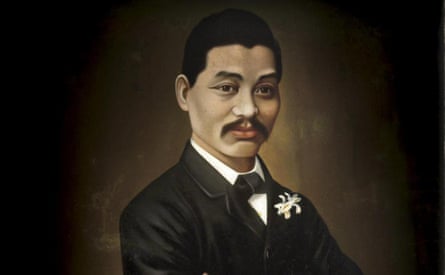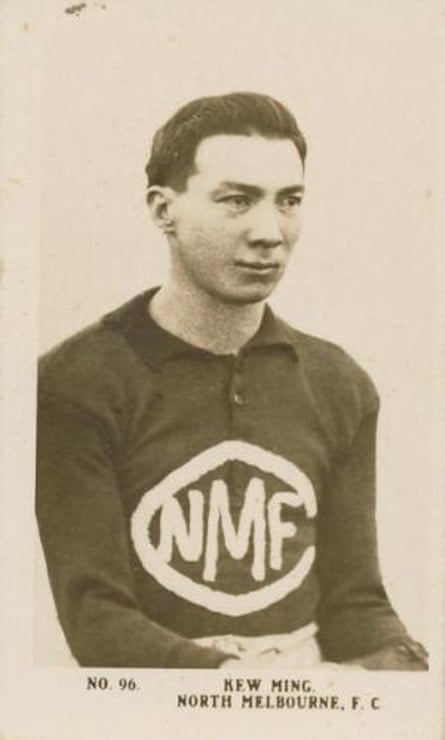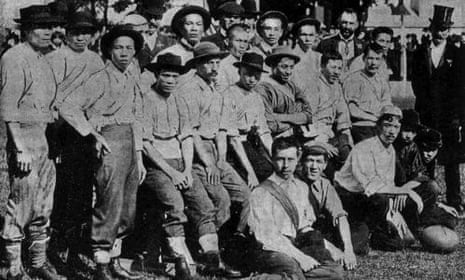Every year 80,000 Chinese tourists travel to Ballarat in regional Victoria to visit the old goldfields of “Tsin Chin Shan” or “Land of the New Gold Mountain”. Their itinerary includes the Gold Museum, Chinese Cemetery, Mine Tour and Sovereign Hill’s recreated Goldfields Village. The tour buses never stop at Eastern Oval, the ground that over 120 years ago hosted a unique part of Australia’s sporting history.
In 1854, Ballarat had become a thriving Chinese colony and many were successful veterans of the great Californian gold rush. By 1890, the town had surrendered the last of its 20 million ounces of gold, and each member of the Chinese community faced a dark night of the soul: to stay or return home.
Locked out of key union jobs, the ones who stayed integrated into the community as market gardeners, herbalists, cabinet makers and laundry managers. These first Chinese Australians were a tough, resilient and adaptable community. And they loved Australian Rules football.
In his office at Victoria University, Dr Rob Hess, a leading historian of early Australian Rules Football history, regaled me with amazing tales of Chinese small town football pioneers: Chin Kit for Ironbark in 1882, Thomas Chin Chee for Inglewood in 1895. In 1903 James Hing of Echuca Football Club became the first Chinese player to win a premiership and also became the first recorded Chinese Australian to be suspended, soundly thrashing Abe Flower of Moama after being racially vilified on the field. And, most intriguingly, the Chinese Goldfields Leagues that started in Ballarat on Friday 26 August, 1892 and soon swept across Victoria.
For the local drinkers at Ballarat’s Red Lion Hotel, that Friday was a day like no other. Chinese and Europeans had come together to witness a historical spectacle: the first Chinese Australian Rules football game.
Ballarat was split by a cultural fault line – English and Cantonese, the flutter of cards and the clacking of Mahjong tiles, whiskey and rice wine, opium and tobacco, Confucius and Jesus. On this day they were united by the great Victorian game.
Golden Point, Ballarat’s Chinatown, was bustling as the curious Chinese community set off from their joss houses, kitchens, market gardens and gambling dens towards Eastern Oval to watch their men play the strange colonial game.
The two Cantonese Chinese teams, the Miners and the Gardeners, assembled in their stockings in front of the Red Lion and were transported in a six-car procession that, according to the Evening Star, “moved through Ballarat on a great scale of magnificence”; a sonic potpourri with Cantonese opera songs punctured by firecrackers thrown to ward off the evil spirits, all to the soundtrack of the townspeople cheering them down the dusty streets.
The newspaper reported the Chinese players had prepared for weeks and were “quite enthusiastic about the matter”.
The match, which kicked off at 2pm, was umpired by Mr George Lepp. Attired in silk Chinese slippers, Lepp was the first Chinese Australian Rules umpire. The Miners were captained by Quong Tart, an extraordinary historical character who straddled the east-west cultural divide with class. Today he is immortalised in bronze outside Ashfield Station in Sydney. Quong Tart spoke English with a thick Scottish accent and introduced café society to Australia through his chain of teahouses. Tart was the quintessential multicultural man, comfortable in a Kilt or Chinese robes, a bagpipe player and an honorary Mandarin of the fourth degree. Philanthropist, merchant, freemason, president of the NSW Victorian Football Club, it’s fitting that Quong Tart kicked off the Chinese Australian Rules tradition.

The “Celestial Football Match” began with a Chinese orchestra that continued playing throughout game. Schoolchildren shouted their support to the players in freshly learnt Cantonese. One crowd highlight reported in the Ballarat Evening Star was a pitch invasion by a European spectator who took a swing at one of the Chinese players. Described as a “muscular son of the sun”, the player “seized the offender and soused him in mud amid applause and laughter of a large group of onlookers”.
The 25-17 victory by the Gardeners over the Miners was reported nationally as a “splendidly contested” match in front of an estimated 5,000 fans, a pivotal moment that gave birth to the Chinese Australian Rules Football tradition.
For a golden decade, charity fundraising matches continued between the Chinese “Little Canton” regional communities of Ballarat, Bendigo, Eaglehawk, Geelong and even Beechworth up in Ned Kelly Country where the Shanghai Reds played the Foochow Greens in 1896.
The Ballarat pre-game template was adopted in all of these games, which were often played with intensity; a telling anecdote comes from a game in Geelong in 1896 featuring the Gardeners, a “full-blooded” Chinese team who played the Miners, a “half-caste” Chinese team.
In an effort to throw the Gardeners off their game, the Miners started pulling and unravelling their opponent’s Manchu pigtails causing a “disturbance” between the players. “This was wrong,” reported The Bulletin, “because the half-castes should have remembered that their fathers were Chinese.”

In 1899, football fever spread to the big city, infecting Melbourne’s Chinese community. A series of Chinese community games were held to raise money for St Vincent’s Hospital including the first international game of Australian Rules Football between “Chinese and Hindoo” teams.
In 1901 the White Australia policy stopped any new Chinese immigration and those that remained faced official discrimination. Ballarat’s Chinatown was demolished, the regional Chinese communities moved into Melbourne and the Goldfields Leagues ceased to exist, the only legacy being the nickname of the Golden Point Football Club, the “Rice Eaters”.
In Melbourne, Chinese players broke into elite football including Carlton’s Wally Koochew, Geelong’s George Tansing, St Kilda’s Ernie Foo and the most famous of all, the fighting footballer, North Melbourne’s Les Kew Ming.
Did the Chinese Australian Rules football tradition survive into the 21st century? Jamie Pi, an Australian Rules fanatic born in Xinjiang province, believes so. “It’s booming,” he said, and yet he had only heard rumours about the Ballarat Goldfields League history. “Why didn’t people tell us about this?” he asked.
Pi is the AFL’s first Mandarin match commentator, the first China-born senior coach and is the current coach of Team China in the AFL International Cup. Pi is a founding member of the Southern Dragons Asian football club that has played in Melbourne since 2007 and tasted success in 2011 winning the Division 3 title in front of hundreds of screaming fans.
“You wouldn’t believe the AFL South China League, how fast it’s growing and how seriously the students are taking it,” said Pi. “AFL clubs such as Port Adelaide are getting behind it and they’ve now got eight teams including the Guangzhou Scorpions. The AFL has gone back to its Cantonese roots.”
Last year, Pi played and coached China to their first ever win against Finland in the International Cup, an experience he describes as “unbelievable”. “It’s coming slowly but surely,” he said. “Here in Melbourne Lin Jong from the Western Bulldogs carries the AFL flag for the Chinese community, with strong Chinese heritage. We have some good prospects in the VFL and TAC Cup pipeline such as Michael Tang from the Coburg Lions and Kenny Ong from the Sandringham Dragons.”

More than a century since the first Chinese Australians played footy, it’s clear the tradition lives on. “These are amazing Australian stories. Chinese players lining up to play the quintessential Australian game in the shadow of the White Australia policy,” said Dr. Hess. “Football was able to bring the European and Chinese communities together and created a decade of tolerance and harmony across Victoria. There’s a rich history that historians have ignored, hidden or marginalised.”
Pi is clearly delighted to carry on that tradition. “We’ve always played the game and we’ll always play it,” he said. “It’s our game too, no matter what anybody says.”
With special thanks to Associate Professor Robert Hess from Victoria University, Edith Fry from the City of Ballarat and Sophie Couchman from the Chinese Museum, Melbourne.

Comments (…)
Sign in or create your Guardian account to join the discussion